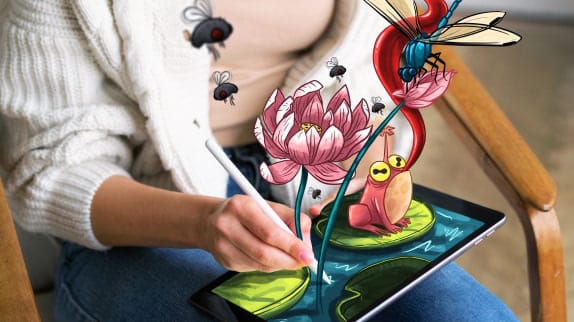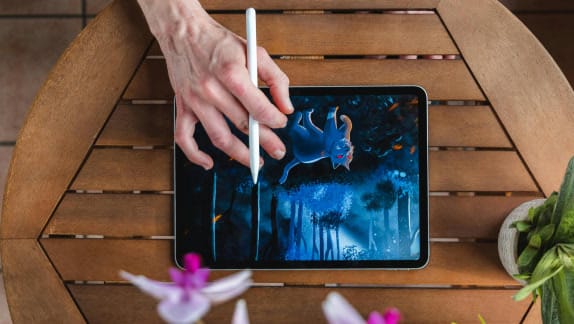How to Become an Illustrator: Turning Passion Projects into a Creative Career

In a recent live event, How to Become an Illustrator, Sessions President Gordon Drummond and Department Head of Illustration Jordon Schranz sat with Eric to talk about what it really takes to build a career in art. He shared the habits, mindsets, and creative strategies that helped him turn passion projects into a sustainable path forward.
Is An Illustration Degree Worth It?
When asked how Eric knew that he wanted to become an artist, he explained that it was never really a decision, but something he simply never stopped doing. “I don’t recall ever deciding to become an artist,” he said. “I just decided to remain one.” Art was an outlet for him growing up when he came up against difficult feelings and over time, that world became his way of connecting with others and finding community, especially in game design.
So how did he turn that lifelong love of art into a career? For Eric, the turning point came when his wife encouraged him to go to school and earn a degree in design. “I think it changed everything,” he said. “When I finished my degree, I went straight into the industry and was never without a job.”
Many aspiring artists wonder, “is a two year creative degree worth it?” For Eric, the answer was yes. He explained to us that the real benefit of going to school was being challenged to do things he wouldn’t have thought to do on his own. “It gave me confidence.”
Like many of our students, Eric came from a humble background and wanted to prove to himself that he could build a professional path from creativity. His early jobs as a designer taught him the technical and collaborative skills that later opened doors. “It was just a paid education,” he said.
His advice for new creatives: don’t dismiss the stepping-stone jobs. Each experience, whether in production, corporate design, or freelancing, teaches you how to work with teams, communicate with clients, and understand the business side of creativity. It’s all part of a valuable education that helps guide you to where you want to land.
Building a Career from Your Portfolio
When it came time to build his portfolio, Eric approached it with intention. While he included some of his professional design work, he made sure his passion projects took center stage. Those personal works showed his range, style, and curiosity—the traits that attract like-minded clients and studios.
“I don’t consider myself a marketer,” he admitted, “but I have to be better about sharing the story behind my projects.” Learning to talk about his work was one of the most valuable lessons he gained from his early jobs in advertising and corporate design.
Your portfolio, in other words, isn’t just a gallery but a storytelling tool. It should explain what inspires you, what problems you like to solve, and how your creative process works.
A recurring theme in Eric’s journey is his openness to feedback. Whether developing a new card game or revising illustrations, he sees critique as collaboration. “You don’t know how many people would love to give their opinion about your game,” he said.
He encourages creatives to share early and often through social media, community events, or local meetups. Studios are looking for personalities that they want to work with—there’s a serious need for people who are able to collaborate with a team. This is why it’s important to show your process in your portfolio. “No one believes we can do something until we can show them we can do it,” Eric explained.
From Sketchbook to Gameboard
Eric’s best-known projects began as personal explorations. Over 25 years, his world-building project World of Raynaga evolved into Iconica, a small-batch indie card game that found loyal fans through online sales.
He later created Flip Doodle, a drawing game born during the pandemic, and Vector Interplay, developed using unused sketches and designs. “It’s important to keep a sketchbook,” Sessions illustration instructor Jordon commented. “You never know… your ideas could become useful years later.”
Eric agreed, offering that “your sketchbook isn’t just for the moment, it’s for future you… they can become very handy for future client work or personal projects.”
His latest series, BugChums, continues that spirit of evolution. Created primarily in Adobe Fresco and Illustrator, it’s a print-and-play tabletop game with a lighthearted, handmade feel. Eric attributes his ability to market his products to things he learned working those early design jobs. It’s essential to explain what your product or work is, what people will be engaging with, and telling your audience what has inspired your work.
For aspiring illustrators and game creators, his method offers a clear takeaway: research the things you’re passionate about, keep building worlds, and let your personal projects double as playgrounds for experimentation and connection.
Evolving Your Illustration Styles
When asked about style, Eric’s advice was simple: don’t force it. “Don’t worry about style—just make your ideas happen,” he said. “You can always go back and look at your work to see where it comes from or where it’s headed.”
He also stressed the importance of adaptability. “Having a few different gears to shift into is really good,” he said.
For creatives, versatility isn’t selling out but staying relevant. “Range is very important when it comes to the projects we work on… if you’re too known for one thing, people will pin that to you and you’ll never be known for more than that.” Keep in mind that your career is going to last a long time, and there’s always time to master skills and evolve your style.
Collaboration, Process, and Personality
To maintain that adaptability, the key is in asking for feedback. “I’m still in touch with my instructors from back when I was in college.” Eric admitted. In his experience, asking questions is the secret sauce for artists and business owners alike because building those relationships and learning about what others feel about your art is essential.
Fans have even become collaborators: one longtime player who became a fan when he was just eight years old grew up and approached Eric at a Con to collaborate on the music for Eric’s upcoming title, BugChums: Bumble Isle. “It’s such a cool example of how you never know who the people you’re interacting with will become, and the ways you can have fun collaborating with them in the future.” Eric said.
It can be nerve wracking to embrace going out and talking to people but with practice, it can help open doors to opportunity and community in a way that posting to social media can’t replace. This is especially important in a world where artists are uncertain about the future of technology and their place in the economy.
“Our job as creatives is to make the work,” Eric said. “It’s not to judge it or hold it back. It’s not to take our light and put that under a basket because we’re afraid. Our job is to let whatever light we have shine out into the world, especially right now.”
Key Takeaways
We appreciate Eric Torres sharing his time and expertise with our student audience. Here is a summary of five takeaways from the event:
- Stay curious. Keep experimenting and learning because your best ideas often start small.
- Challenge yourself. Education, whether formal or self-driven, is what turns talent into skill.
- Share your work. Feedback is fuel for growth, not criticism to fear.
- Stay adaptable. Range and flexibility are what keep your creative career thriving.
- Build community. The people who play, view, or comment on your work today might collaborate with you tomorrow.
Build Your Portfolio With Us
If you are a high school graduate, you can study with illustrator Jordon Schranz, and other experts in the industry by becoming a student with Sessions College. With various program levels available, students are able to build out their own education journey.
- Begin with the 24-credit Undergraduate Certificate in Illustration. Learn the fundamentals of digital art and begin building a body of work along the way.
- Advance to a 72-credit Associate Degree in Illustration. Build advanced skills, learn to market yourself as an illustrator, and finish with a guidance-backed portfolio.
- Complete your journey with a 120-credit Bachelor’s Degree in Illustration. Begin honing in on your style by creating projects based on what you’re passionate with feedback from instructors, and then celebrate your graduation with a professionally published portfolio.

Jessica is the Product Marketing Manager at Sessions College, ensuring a consistent message across all marketing touchpoints, using branding and lifecycle marketing email campaigns, onboarding communications, retention strategies, and engagement initiatives. Read more articles by Jessica.
RELATED ARTICLES:
SESSIONS NEWS:
ENROLL IN AN ONLINE PROGRAM AT SESSIONS COLLEGE:





